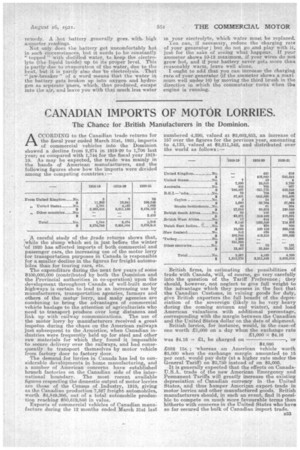CANADIAN IMPORTS OF MOTOR LORRIES.
Page 29

If you've noticed an error in this article please click here to report it so we can fix it.
The Chance for British Manufacturers in the Dominion.
ACCORDING to the Canadian trade returns for the fiscal year ended March 31st, 1921, imports of commercial vehicles into the Dominion showed a decline from 2,274 in 1919-20 to 1,'706 last year, as compared with 1,744 for the fiscal year 1918 .19. As may be expected, the trade was mainly in the hands of American manufacturers, and the following figures show how the imports were divided among the competing countries:
'A careful study of the itrade returns shows that, ',while the slump which set in just before the winter 'of 1920 has affected imports of both commercial and passenger cars„ the increasing use of the motor lorry lor transportation purposes in Canada is responsible for a, smaller decline in the figures for freight automobiles than for touring ears, etc. The expenditure during the next few years of some $100,000,000 (contributed by both the Dominion and i
the Provincial authorities n co-operation) upon the development throughout Canada of well-built motor highways is certain to lead to an increasing use by manufacturers, transportation agencies, farmers and others of the moter lorry, and many agencies are combining to bring the advantages of commercial vehicle haulage to the attention of agriculturists who need to transport produce over long distances and link up with railway communications. The use of the motor lorry by manufacturers received a great impetus during the chaos on the American railways just subsequent to the Armistice, when Canadian industries were frequently held up for steel and other raw materials for which they found it impossible to secure delivery over the railways, and had consequently to transport themselves by motor vehicle from factory door to factory door.
The demand for lorries. in Canada has led to considerable developments in home manufacturing, and a number of American concerns have established branch factories on the Canadian side of the international boundary. The most recent available figures respecting the domestic output of motor lorries are those of the Census of Industry, 1919, giving as the Canadian production 7,527 freight automobiles, worth $4,849,398, out of a total automobile produc-tion reaching $80,619,846 in value.
Exports of commercial vehicles of Canadian Ma/1UL facture during the 12 months ended March 31st last
numbered 4,290, valued at $2,602,853, an increase of 157 over -the figures for the previous year, amounting to 4,133, valued at $2,211,342, and distributed over the world as follows: British firms, in estimating the possibilities of trade with Canada, will, of course, go very carefully into the question of the Tariff Preference; they should, however, not neglect to give full weight to the advantage which they possess in the fact that the Canadian Customs, in valuing goods for duty, give British exporters the full benefit of the depreciation of the sovereign (likely to be very heavy during the coming autumn and winter), and load American valuations with additional percentage, corresponding with the margin between the Canadian and the United States dollar on the date of shipment.
British lorries, for instance, would, in the case-of one worth £1,000 on a day when the exchange rate x $4.16 was $4.16 = £1, be charged on , or $4.866
£852 15s.; 'whereas an American vehicle worth $5,000 when the exchange margin amounted to 15 per cent. would pay duty (at a higher rate under the General Tariff) on $5,750 instead of on $5,000. It is generally expected that the effects on Canadatrade of the new American Emergency and Permanent Tariffs will greatly increase the existing depreciation of Canadian currency in the United States' and thus hamper American export trade in motor lorries and other manufactured goods. British manufacturers should, in such an event, find it possible to compete on much more favourable terms than hitherto with concerns in the United States who have so far secured the bulk of Canadian import trade. B33
































